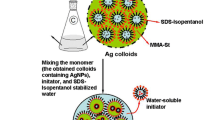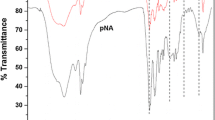Abstract
In this manuscript, we accomplished the engineering of poly(methacrylic acid) [p(MAA)] micron-sized microgel (MG) integrated with silver nanoparticles (AgNPs). The micron-sized p(MAA) MG particles were synthesized by inverse suspension polymerization, and fabrication of silver nanoparticles was carried out via chemical reduction of Ag(I) ions in the synthesized MG network. The synthesized p(MAA) MG and p(MAA)–AgNPs composite was subjected for compositional and morphological analysis with Fourier transform infrared (FTIR), scanning electron microscopy (SEM), energy-dispersive X-ray (EDX), X-ray diffraction (XRD), spectroscopy, and thermal gravimetric analyzer (TGA). The p(MAA) MG particles were observed to be spherical in shape with diameters in the range of 60–95 µm and found thermally stable below 225 °C. The existence of Ag in the p(MAA) MG was approved by EDX analysis. The prepared p(MAA)–AgNPs composite exhibited promising catalytic performance in the reduction of four different nitro-aromatic compounds including 4-nitrophenol (4-NP), 2-nitrophenol (2-NP), 2-nitroaniline (2-NA), and 4-nitroaniline (4-NA) with maximum reduction rates of 0.4205, 1.1222, 0.5195, and 1.6424 min−1, respectively. The catalyst was recycled for five consecutive cycles by a cost and time-effective process of filtration with gradual decrease in the catalytic activity to 10%. Also, the prepared p(MAA)–AgNPs composite was found active against Gram-negative E. coli and Gram-positive S. aureus with corresponding inhibition zones of 7 mm and 9 mm, respectively.















Similar content being viewed by others
References
Kamoun EA, Kenawy E-RS, Chen X (2017) A review on polymeric hydrogel membranes for wound dressing applications: PVA-based hydrogel dressings. J Adv Res 8:217–233
Ajmal M, Siddiq M, Aktas N, Sahiner N (2015) Magnetic Co–Fe bimetallic nanoparticle containing modifiable microgels for the removal of heavy metal ions, organic dyes and herbicides from aqueous media. RSC Adv 5:43873–43884
Cao J, Wang P, Liu Y, Zhu C, Fan D (2020) Double crosslinked HLC-CCS hydrogel tissue engineering scaffold for skin wound healing. Int J Biol Macromol 155:625–635
Dreiss CA (2020) Hydrogel design strategies for drug delivery. Curr Opin Colloid Interface Sci 48:1–17
Ajmal M, Siddiq M, Al-Lohedan H, Sahiner N (2014) Highly versatile p (MAc)–M (M: Cu Co, Ni) microgel composite catalyst for individual and simultaneous catalytic reduction of nitro compounds and dyes. RSC Adv 4:59562–59570
Haleem A, Syaal SB, Ajmal M et al (2020) Silver and palladium nanoparticle embedded poly(n-isopropylacrylamide-co-2-acrylamido-2-methylpropane sulfonic acid) hybrid microgel catalyst with pH and temperature dependent catalytic activity. Korean J Chem Eng 37:614–622
Naseem K, Begum R, Farooqi ZH, Wu W, Irfan A (2020) Core–shell microgel stabilized silver nanoparticles for catalytic reduction of aryl nitro compounds. Appl Organomet Chem 34:e5742
Sahiner N (2013) Soft and flexible hydrogel templates of different sizes and various functionalities for metal nanoparticle preparation and their use in catalysis. Prog Polym Sci 38:1329–1356
Farooqi Z, Khan S, Begum R (2017) Temperature-responsive hybrid microgels for catalytic applications: a review. Mater Sci Technol 33:129–137
Farooqi ZH, Khan SR, Hussain T et al (2014) Effect of crosslinker feed content on catalaytic activity of silver nanoparticles fabricated in multiresponsive microgels. Korean J Chem Eng 31:1674–1680
Wahid F, Zhong C, Wang H-S, Hu X-H, Chu L-Q (2017) Recent advances in antimicrobial hydrogels containing metal ions and metals/metal oxide nanoparticles. Polymers 9:636
Shahid M, Farooqi ZH, Begum R, Arif M, Wu W, Irfan A (2020) Hybrid microgels for catalytic and photocatalytic removal of nitroarenes and organic dyes from aqueous medium: a review. Crit Rev Anal Chem 50:513–537
Begum R, Farooqi ZH, Aboo AH, Ahmed E, Sharif A, Xiao J (2019) Reduction of nitroarenes catalyzed by microgel-stabilized silver nanoparticles. J Hazard Mater 377:399–408
Li S, Lin D, Zhou J, Zha L (2016) Preparation of silver nanoparticles loaded photoresponsive composite microgels and their light-controllable catalytic activity. J Phys Chem C 120:4902–4908
Farooqi ZH, Khan SR, Begum R et al (2015) Effect of acrylic acid feed contents of microgels on catalytic activity of silver nanoparticles fabricated hybrid microgels. Turk J Chem 39:96–107
Liu Y-Y, Liu X-Y, Yang J-M, Lin D-L, Chen X, Zha L-S (2012) Investigation of Ag nanoparticles loading temperature responsive hybrid microgels and their temperature controlled catalytic activity. Colloids Surf Physicochem Eng Asp 393:105–110
Vescovo R, Becker M, Natile MM, Canton P, Evangelisti C, Biffis A (2021) Microgels as soluble scaffolds for the preparation of noble metal nanoparticles supported on nanostructured metal oxides. ACS Appl Nano Mater 4:8343–8351
Roymahapatra G, Mandal SM, Porto WF et al (2012) Pyrazine functionalized Ag(I) and Au(I)-NHC complexes are potential antibacterial agents. Curr Med Chem 19:4184–4193
Knapp AR, Panzner MJ, Medvetz DA, Wright BD, Tessier CA, Youngs WJ (2010) Synthesis and antimicrobial studies of silver N-heterocyclic carbene complexes bearing a methyl benzoate substituent. Inorg Chim Acta 364:125–131
Huang W, Zhang R, Zou G, Tang J, Sun J (2007) An iodide/anion exchange route to benzimidazolylidene silver complexes from benzimidazolium iodide: crystal structures of N, N′-dibutylbenzimidazolylidene silver chloride, bromide, cyanide and nitrate. J Organomet Chem 692:3804–3809
Lansdown AB (2002) Silver I: its antibacterial properties and mechanism of action. J Wound Care 11:125–130
Gangadharan D, Harshvardan K, Gnanasekar G, Dixit D, Popat KM, Anand PS (2010) Polymeric microspheres containing silver nanoparticles as a bactericidal agent for water disinfection. Water Res 44:5481–5487
Sondi I, Salopek-Sondi B (2004) Silver nanoparticles as antimicrobial agent: a case study on E. coli as a model for Gram-negative bacteria. J Colloid Interface Sci 275:177–182
Damm C, Münstedt H, Rösch A (2007) Long-term antimicrobial polyamide 6/silver-nanocomposites. J Mater Sci 42:6067–6073. https://doi.org/10.1007/s10853-006-1158-5
Hoskins JS, Karanfil T, Serkiz SM (2002) Removal and sequestration of iodide using silver-impregnated activated carbon. Environ Sci Technol 36:784–789
Kim B, Song WC, Park SY, Park G (2021) Green synthesis of silver and gold nanoparticles via Sargassum serratifolium extract for catalytic reduction of organic dyes. Catalysts 11:347
Monti GA, Correa NM, Falcone RD, Silbestri GF, Moyano F (2021) New Insights into the catalytic activity and reusability of water-soluble silver nanoparticles. ChemistrySelect 6:7436–7442
Narayanan R, El-Sayed MA (2005) Catalysis with transition metal nanoparticles in colloidal solution: nanoparticle shape dependence and stability. J Phys Chem B 109:12663–12676
Butun S, Sahiner N (2011) A versatile hydrogel template for metal nano particle preparation and their use in catalysis. Polymer 52:4834–4840
Narayanan RK, Devaki SJ (2015) Brawny silver-hydrogel based nanocatalyst for reduction of nitrophenols: studies on kinetics and mechanism. Ind Eng Chem Res 54:1197–1203
Zheng Y, Wang A (2012) Ag nanoparticle-entrapped hydrogel as promising material for catalytic reduction of organic dyes. J Mater Chem 22:16552–16559
Wu X-Q, Wu X-W, Huang Q, Shen J-S, Zhang H-W (2015) In situ synthesized gold nanoparticles in hydrogels for catalytic reduction of nitroaromatic compounds. Appl Surf Sci 331:210–218
Ajmal M, Anwar S, Naeem H, Zia MA, Siddiq M (2020) Poly(acrylic acid) hydrogel microparticles fabricated with silver nanoparticles: synthesis, characterization, and catalytic applications. Polym Eng Sci 60:2918–2929
Xiong Z, Zhang H, Zhang W, Lai B, Yao G (2019) Removal of nitrophenols and their derivatives by chemical redox: a review. Chem Eng J 359:13–31
Zhao P, Feng X, Huang D, Yang G, Astruc D (2015) Basic concepts and recent advances in nitrophenol reduction by gold-and other transition metal nanoparticles. Coord Chem Rev 287:114–136
Ai L, Jiang J (2013) Catalytic reduction of 4-nitrophenol by silver nanoparticles stabilized on environmentally benign macroscopic biopolymer hydrogel. Bioresour Technol 132:374–377
Feng Y, Yin J, Liu S, Wang Y, Li B, Jiao T (2020) Facile synthesis of Ag/Pd nanoparticle-loaded poly(ethylene imine) composite hydrogels with highly efficient catalytic reduction of 4-nitrophenol. ACS Omega 5:3725–3733
Sahiner N, Karakoyun N, Alpaslan D, Aktas N (2013) Biochar-embedded soft hydrogel and their use in Ag nanoparticle preparation and reduction of 4-nitro phenol. Int J Polym 62:590–595
Albukhari SM, Ismail M, Akhtar K, Danish EY (2019) Catalytic reduction of nitrophenols and dyes using silver nanoparticles@cellulose polymer paper for the resolution of waste water treatment challenges. Colloids Surf Physicochem Eng Asp 577:548–561
Beiranvand M, Farhadi S, Mohammadi A (2019) Graphene oxide/hydroxyapatite/silver (rGO/HAP/Ag) nanocomposite: synthesis, characterization, catalytic and antibacterial activity. Int J Nano Dimens 10:180–194
Farooqi ZH, Naseem K, Begum R, Ijaz A (2015) Catalytic reduction of 2-nitroaniline in aqueous medium using silver nanoparticles functionalized polymer microgels. J Inorg Organomet Polym Mater 25:1554–1568
Vadakkekara R, Chakraborty M, Parikh PA (2012) Reduction of aromatic nitro compounds on colloidal hollow silver nanospheres. Colloids Surf Physicochem Eng Asp 399:11–17
Ajmal M, Demirci S, Siddiq M, Aktas N, Sahiner N (2015) Betaine microgel preparation from 2-(methacryloyloxy) ethyl] dimethyl (3-sulfopropyl) ammonium hydroxide and its use as a catalyst system. Colloids Surf Physicochem Eng Asp 486:29–37
Ajmal M, Aftab F, Bibi I et al (2019) Facile synthesis of porous anionic hydrogel embedded with nickel nanoparticles and evaluation of its catalytic performance for the rapid reduction of 4-nitrophenol. J Porous Mater 26:281–290
Naeem H, Ajmal M, Muntha S, Ambreen J, Siddiq M (2018) Synthesis and characterization of graphene oxide sheets integrated with gold nanoparticles and their applications to adsorptive removal and catalytic reduction of water contaminants. RSC Adv 8:3599–3610
Acknowledgements
Financial support from Higher Education Commission (HEC), Pakistan, under Master leading to PhD, for the students of Aghaz-e-Haqooq-e-Balochistan Package is highly acknowledged. The authors also wishes to acknowledge Princess Nourah bint Abdulrahman University Researchers Supporting project (Grant No. PNURSP2022R55), Princess Nourah bint Abdulrahman University, Riyadh, Saudi Arabia.
Author information
Authors and Affiliations
Corresponding authors
Ethics declarations
Conflict of interest
The authors declare that they have no conflict of interest.
Additional information
Handling Editor: Annela M. Seddon.
Publisher's Note
Springer Nature remains neutral with regard to jurisdictional claims in published maps and institutional affiliations.
Rights and permissions
About this article
Cite this article
Rahman, S., Al-Harbi, F.F., Ajmal, M. et al. Engineering of micron-sized spherical anionic microgel fabricated with silver nanoparticles with antimicrobial and catalytic potential. J Mater Sci 57, 6763–6779 (2022). https://doi.org/10.1007/s10853-022-07042-w
Received:
Accepted:
Published:
Issue Date:
DOI: https://doi.org/10.1007/s10853-022-07042-w




